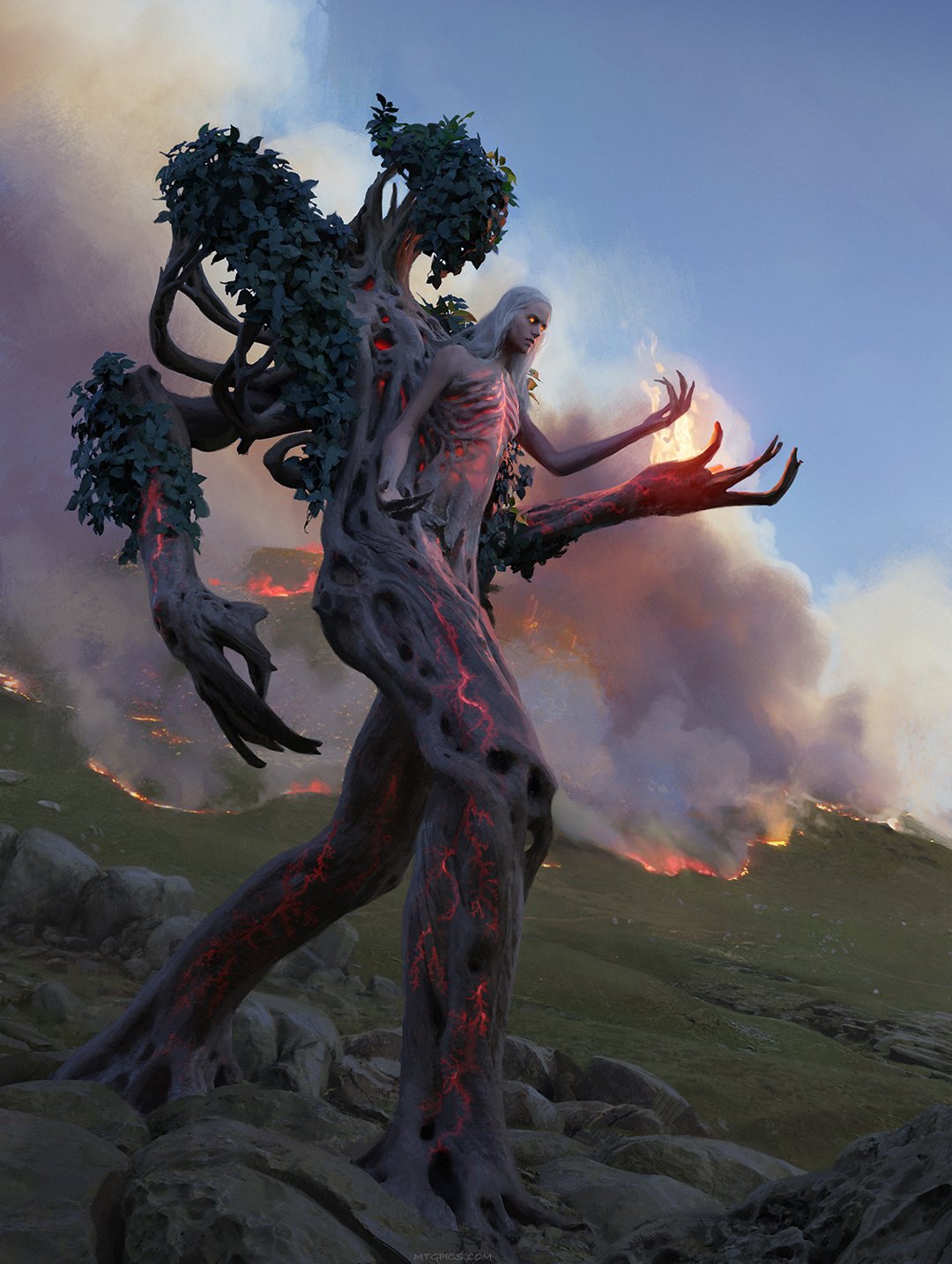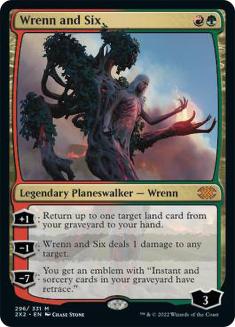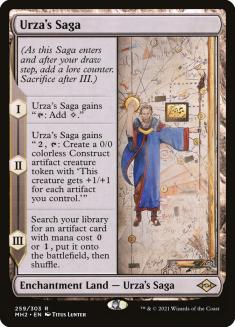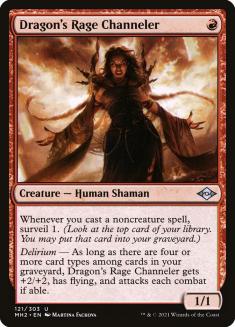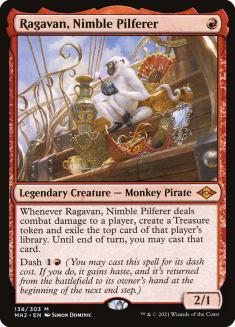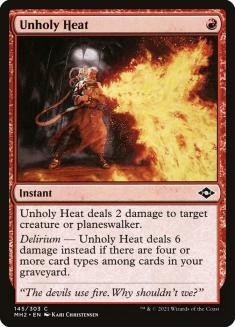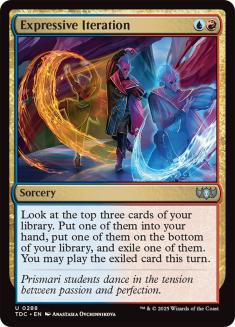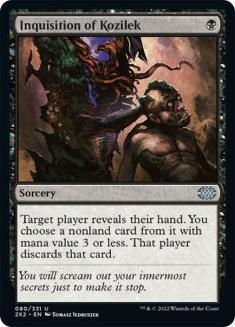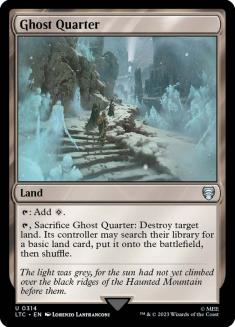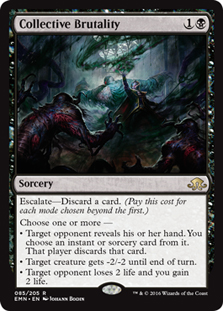When it comes to building decks, especially in a format as powerful as Modern, you have to make balance changes. The sliding scale I use looks something like “Consistency <—> Power.” If you want to mulligan less, you need to sacrifice some of your explosiveness for measures that increase consistency. If you’re losing because you’re drawing too many weak or one dimensional cards, maybe it’s time to slide the scale a little bit to the right. Take out a one drop or two and add in some beef, or just up your curve slightly. If you find yourself drawing too many spells that you can’t cast, perhaps the reverse is in order. This type of deckbuilding is obvious in limited, but a little harder to solve in constructed.
Building a deck is all about making compromises. You add in a land when you find yourself short on mana on later turns. You cut a land if you find yourself flooding too often. And so it goes, over and over again, every weekend there’s a new tournament, until the end of time. It’s not a bad life, all things considered. It allows us to express our creativity through pairing variables together in the hopes that the gameplay engine will help our vision come to life. There’s little more frustrating in the sphere of Magic than having your cool new deck burn out too quickly or never even get off the ground. In the age of Magic Arena, building a new deck only to have it blow up in your face is fairly costly.
So when someone showed up to the party playing Wrenn and Six alongside Urza’s Saga, you could say I had my doubts. Wrenn and Six isn’t a surprise Modern player. It’s an exceptional card that was banned in Legacy for its interaction with Wasteland. It helps Gruul archetypes ping small creatures so the spot removal like Lightning Bolt can take care of the more important stuff. It also doesn’t have a colorless mana symbol in the casting cost.
Urza’s Saga has been a standout card in Modern as a build around toolbox and self-contained engine. The Constructs add a kick to decks that just want the tutor effect, and the tutor effect is quite strong in decks that want Urza’s Saga for the Constructs. It’s a complete card that offers variability in gameplay and rewards deck construction. Cards that tutor are often thought of as the most difficult cards to play in Magic, but Urza’s Saga makes it look easy. You only have a few options at any given time, and you usually want to be making tokens, so your gameplay is relatively static.
Because Urza’s Saga is a land that taps for colorless mana, you should normally look at filling your deck with easy-to-cast cards. That could mean light on colored mana symbols or even just a bunch of artifacts to ensure you can use Urza’s Saga as it was originally intended: a land. Adding a two-color, two-mana spell to the mix looks foolish on paper, but ends up being anything but. Your late-game is so outrageous in fair matchups, as a single Urza’s Saga is worth so much. If you can ensure a new Urza’s Saga every turn, anyone trying to use removal spells on you is going to have a bad time.
Today’s article will examine multiple builds featuring the dynamic duo (trio?) of Wrenn and Six and Urza’s Saga.
Temur Box: New Additions
If you told me a few months ago that I would put Urza’s Saga into the Temur Box™, the box of cards I keep that contain all my favorite Temur cards for building decks on the fly, I would have called you a liar or a genius. Only time would tell which you were. As it happens, I’m the fool and you are very very smart.
Creatures (12)
Planeswalkers (3)
Lands (21)
Spells (24)

Since this deck contains Wrenn and Six and Urza’s Saga, it’s important to have the third color be mostly a splash. The core of the deck looks a whole lot like the red decks we’ve come to expect in Modern.
This core of cards has given new life to Rakdos, Jund, and all sorts of other archetypes that we haven’t even seen before now, including the Wrenn and Saga variants we’re discussing today. This core is exceptional, and should be looked at as a base starting point for any deck that wants to play fair. It’s like Delver of Secrets, Daze, Wasteland, and Force of Will in Legacy. If you want to fend off the combo decks, those four cards are a great place to start. If you want to play fair, these four red cards offer a potent entrance point.
Since our deck has these four cards you can already assume we’re going to do pretty well in the early turns. We’re great at containing creatures due to the cheap removal, and have pressure to apply to the slower opponents. We punish them for not having removal by gaining a massive mana advantage via Ragavan and smooth our draws easily with Dragon’s Rage Channeler (DRC).
The Izzet decks doing well in Modern have been jamming four copies of Murktide Regent, but I’ve heard a lot of buzz about swapping blue for green so we can play Tarmogoyf. Delving your entire graveyard is a bit awkward at times, even going so far as to turn off delirium for DRC. Tarmogoyf is a perfect threat for this archetype, as it includes a colorless mana in the cost and grows rapidly in strength with the same cards that enable DRC.
The base of the deck is red, and that base can function autonomously. The secondary color of blue or green or whatever doesn’t matter much, and is chosen due to which support cards are better in a given build or metagame. This build is trying to pair the best one-drop spells in the format with the best land. Tarmogoyf is a freebie threat that’s at home in this deck, but Wrenn and Six is another cheap spell that adds a new dimension.
DRC decks are notorious for being great at grinding out the game. Lurrus of the Dream-Den or Kroxa, Titan of Death’s Hunger are often seen alongside it because they’re graveyard centric threats that offer the wielder longevity. If we play green, you need a spell that can win the long game. Wrenn and Six recurring Urza’s Saga over and over again should be good enough to win any attrition battle as long as you have a few toolbox artifacts to contain your opponent’s recursive elements.
The extra blue splash here is actually pretty hilarious. Fire is a stellar card and Ice is just extra payoff. Split cards are excellent for builds like this because you can easily cast the front half, but access to the back half in sticky situations gives you some percentage points against weirdo decks. Fire/Ice is one of my favorite cards of all time, and the addition of it here is genius.
Expressive Iteration is a head-scratcher though, or at least it is until you think about the timing on when you actually want to cast it. Expressive Iteration is a card I’ve played a good bit with but I’ve done more theorycrafting on how to best utilize it. It works well in decks with free spells like Mishra’s Bauble so you can get extra cards out of the exile clause without much work, but the true path is casting it as late in the game as you can stand. As the game progresses, Expressive Iteration is one of the most explosive spells you can cast because it ends up being two of the three best spells from the top of your library. Alternatively, it helps smooth your draws on the third or fourth turn by helping you hit land drops and finding your key pieces of interactions or extra threats in the face of removal.
There’s quite a bit of tension between Urza’s Saga and Expressive Iteration, to the point that I’m not sure it is actually worth it. Where Fire/Ice is free, Expressive Iteration has a heavy cost. You normally want to be playing Urza’s Saga on the second turn so you can start churning out Constructs on the third and fourth turns. Expressive Iteration is for casting on the third turn when you need to hit a land, but becomes awkward at any point where Urza’s Saga is already on the battlefield. For that reason, and that reason alone, I don’t think blue is the right color for this archetype.
Zoomer Jund: The Kids are Alright
The original versions of this deck didn’t really get off the ground. They limited themselves to Gruul, which were decent but ultimately weak at interacting with noncreature spells. Without discard or counterspells some combo or engine decks pose a serious threat. Adding a color for either of these elements is a great way to get a leg up on opponents who are trying to play unfair, or threaten to go way over the top of your meat-and-three strategy. We play fair, and our draws are smooth, so we want cards that force our opponent to come down to our turf. This is literally why we have the term “to level the playing field.”
The most recent build of Wrenn and Saga features a black splash for discard and Lurrus. The discard elements give you interaction beyond killing a creature, and are great for stalling out your opponent by taking their best or most unique spells. This opens the door for Urza’s Saga to eventually take over the game. Without that alternate form of interaction, you have no way to guarantee that you can extend the game. Cards like Urza’s Saga are only as good as the game is long, since you need time to develop the extra cards generated by the land.
Wrenn and Six adds depth to that longevity, but how good is gaining card advantage if you die with six in hand? The extra support color needs to be light thanks to the restrictive nature of Urza’s Saga, and you have to be able to cast those spells in the early turns so you don’t gum up the works when you get Urza’s Saga online. One-mana discard spells fit the bill, and are already proven effective with Ragavan and DRC.
Creatures (12)
Planeswalkers (4)
Lands (24)
Spells (20)

While Milan is not the progenitor of this archetype, his recent build is clean and his results speak louder than my words. He’s one of the youngest and brightest minds in the game, and his take on this archetype is a great starting point. Each iteration of Zoomer Jund looks better and better, and I’m confident we’re almost to the finish line. Let’s take a closer look at the deck and figure out what could be improved.
My personal experience with Ghost Quarter is extremely negative. I’ve played it in hundreds of decks, but it only really “works” in a desperation sense. It helps stifle Inkmoth Nexus in a pinch, and can stall out a Tron deck for a turn, but the downside is that it doesn’t cast very many spells in the deck. If you had some way to tutor for it, I would probably keep playing one, but it just doesn’t do enough here. I’d cut it immediately for a Copperline Gorge.
Fetching a Swamp in the early turns is pretty bad. You have very few black cards in the deck, and you have very few colorless cards to use the black mana on otherwise. When you put multiple lands in your deck that have this problem, you start to see it come up too often for my taste. I would replace this land with a Nurturing Peatland, as it combines well with Wrenn and Six if you don’t have Urza’s Saga online. If you’re afraid of Blood Moon, which is slowly being supplanted by Alpine Moon, you can always sideboard a Swamp.
My gut is telling me that two copies of Lightning Bolt is wrong, but I’m not positive. I’ve seen Jund cut down on Lightning Bolts in the past in favor of Fatal Push, and Unholy Heat plays a similar role. I would only want to cut down on these if I feel like there are little to no creatures in the format, which just isn’t the case. DRC and Ragavan are running rampant, and many of the combo decks are actually creature-based, which makes loading up on removal pretty good for right now.
Finding space for everything is tough though, so I can definitely understand why the cut was made. Depending on how the games actually play out in some of the grindier matchups, I would imagine trimming one Wrenn and Six is okay, and maybe a land. If we think the Ghost Quarter just isn’t worth it, we might want to go down to 23 lands and cut it completely to make space.
The sideboard is a different story. I can’t find much fault there. Fun additions like Run Afoul help fight threats we’re ill-equipped to handle. Murktide Regent is specifically nightmarish, but you can occasionally snag a sneaky Emrakul, the Aeons Torn from Through the Breach. Torpor Orb stops all the creature-based combo decks. Void Mirror slows down both Tron and Cascade decks. Ancient Grudge rules. My only gripe is the Terminate, and maybe the Engineered Explosives. Terminate is a little tough to cast and Engineered Explosives kills all the same stuff that’s in our deck, but both answer problems we couldn’t otherwise.
A Boomer Updates Zoomer Jund
Here’s the list I would play this weekend.
Creatures (12)
Planeswalkers (4)
Lands (23)
Spells (21)

Thoughtseize hasn’t impressed me much, and I found myself drawing a few too many discard spells in key spots, or not having the right mana to cast them when I need. Black is mainly for Lurrus of the Dream-Den, but there are still a few pieces of disruption to keep your opponent honest.
With so many extra resources and you spending most of your time and mana on Urza’s Saga, you need your spells to gain extra value when you actually take the time to cast them. Collective Brutality helps you grow Tarmogoyf, keeps your sorcery speed count high, and has variable usage among different matchups. It’s an absolute dagger to the heart against Burn, which is seeing a resurgence in play.
I like that this spell can give you delirium or pump Tarmogoyf an extra point or two. The two life drain combined with Lightning Bolt can steal games you have no business winning. The absolute blowout turns where you kill their creature and make them discard is nutty. It also has colorless in the casting cost, which means you can use Urza’s Saga to cast it on the second turn if you don’t have a Tarmogoyf ready.
These changes are minor, but they should help in some of the tougher matchups. I don’t think Thoughtseize, or overloading on discard, is worth it right now. I like lightly splashing in this deck, as any sort of heavy splash knocks off the equilibrium.
This is the next big Modern deck. It incorporates two of the best cards from Modern Horizons II into one tight package. There are some bumps along the way, but you have to think of Urza’s Saga as more than just a land. It taps for mana as a secondary ability rather than a primary. Once it is online, your entire goal should be dedicated to using it in the best way possible. Wrenn and Six helps perpetuate this play pattern over multiple turns, effectively generating an infinite amount of resources and pressure.
If you’ve ever played Jund before, this Zoomer update from a Boomer should be right up your alley. Maybe one day they’ll ban Lurrus of the Dream-Den so I can go back to playing Liliana of the Veil, but for now let’s keep trying to stuff Lurrus into everything. It’s just too good to ignore, so lightly splashing for it in a deck that can easily meet the requirements is not only recommended, but actively encouraged. There is still plenty of work to be done on this archetype. Since it is relatively new, you can rest assured I’ll be picking through Gatherer looking for long-forgotten removal spells and sideboard cards to fit in. Colorless mana is gonna come in clutch, and I can already smell the Sudden Edicts cooling on the windowsill from here. Finding that right sideboard card or potential maindeck upgrade is what I live for. Until next time…

